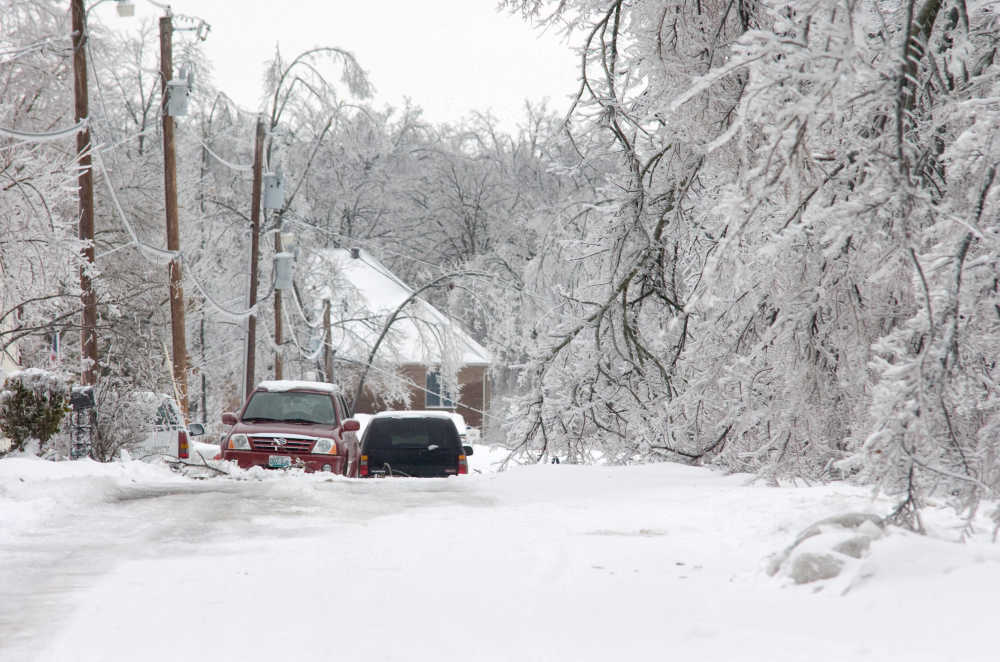-
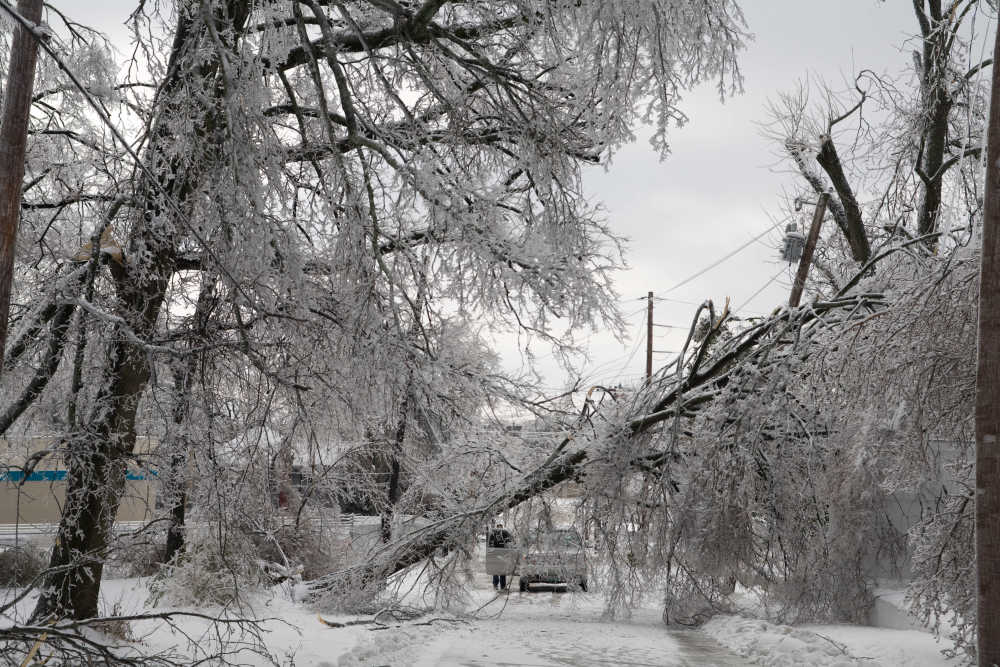 Motorists look at a fallen tree on Fifth Street in Poplar Bluff on Jan. 28, 2009.
Motorists look at a fallen tree on Fifth Street in Poplar Bluff on Jan. 28, 2009. -
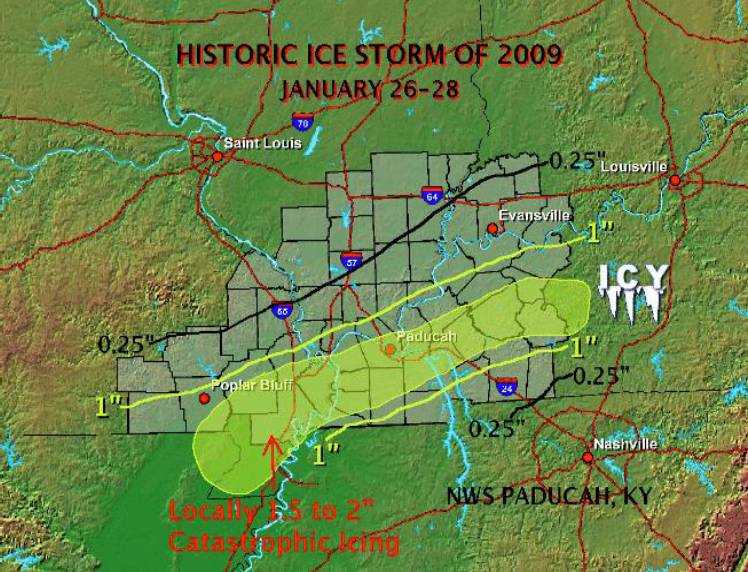 A Jan. 26-28, 2009, winter storm is considered by the National Weather Service to be the weather event of the decade (2000-2009) for the Paducah coverage area.
A Jan. 26-28, 2009, winter storm is considered by the National Weather Service to be the weather event of the decade (2000-2009) for the Paducah coverage area. -
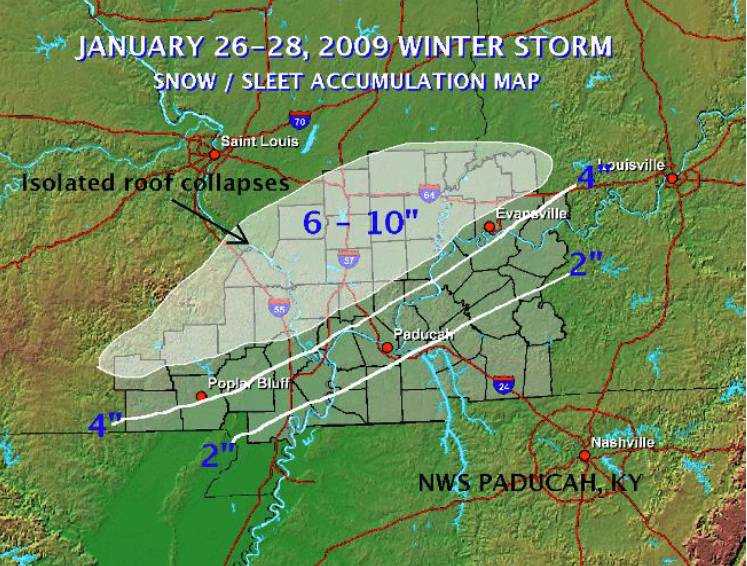 A Jan. 26-28, 2009, winter storm is considered by the National Weather Service to be the weather event of the decade (2000-2009) for the Paducah coverage area.
A Jan. 26-28, 2009, winter storm is considered by the National Weather Service to be the weather event of the decade (2000-2009) for the Paducah coverage area. -
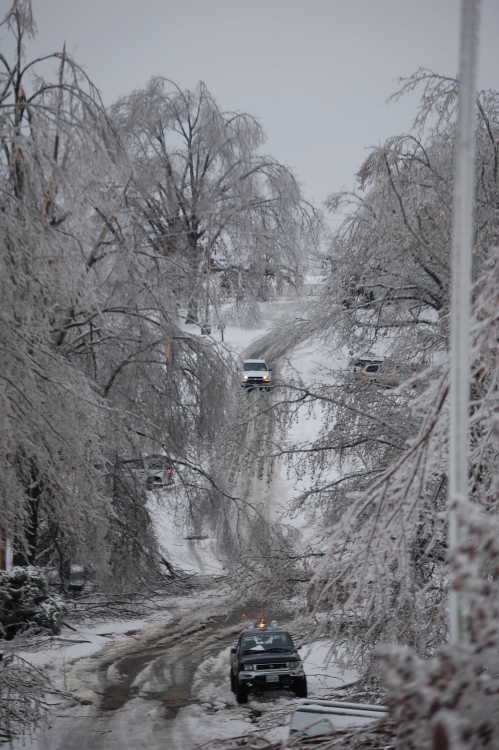 A motorist attempts to navigate his sport-utility vehicle Jan. 28, 2009, around downed trees on Glendale Road in the Town & Country Subdivision.
A motorist attempts to navigate his sport-utility vehicle Jan. 28, 2009, around downed trees on Glendale Road in the Town & Country Subdivision. -
 Ice hangs on a power line Jan. 29, 2019, in Poplar Bluff, after the area sees a catastrophic amount of up to 2 inches.
Ice hangs on a power line Jan. 29, 2019, in Poplar Bluff, after the area sees a catastrophic amount of up to 2 inches. -
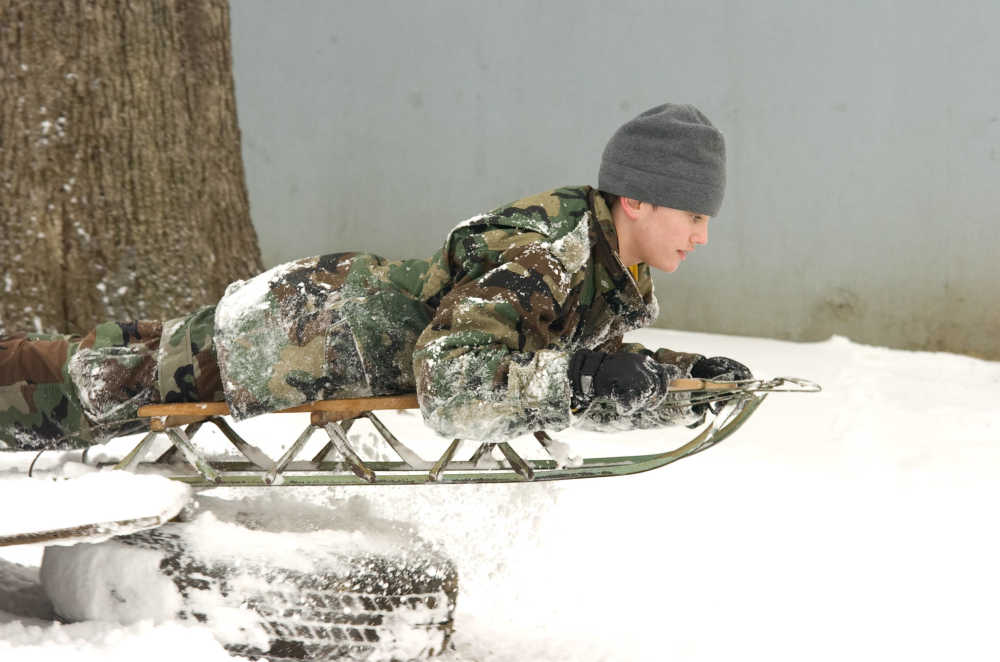 Kerry Bradley jumps a homemade ramp with his sled outside his Orr Street home Jan. 28, 2009.
Kerry Bradley jumps a homemade ramp with his sled outside his Orr Street home Jan. 28, 2009. -
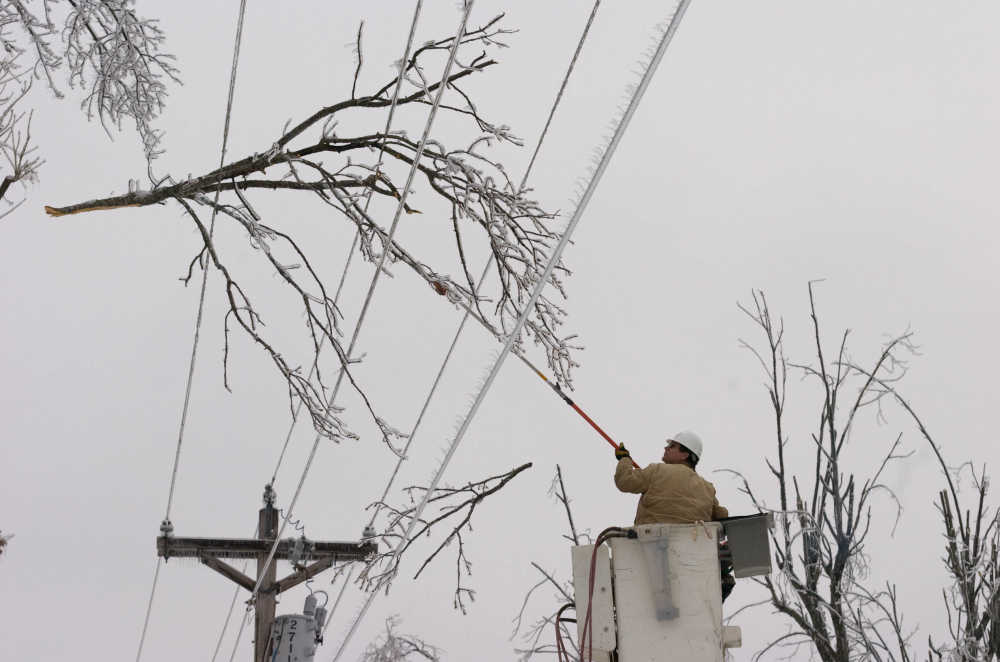 Municipal Utilities lineman Ronnie Barker uses a chainsaw to cut a tree limb off powerlines along Orr Street on Jan. 28, 2009.
Municipal Utilities lineman Ronnie Barker uses a chainsaw to cut a tree limb off powerlines along Orr Street on Jan. 28, 2009. -
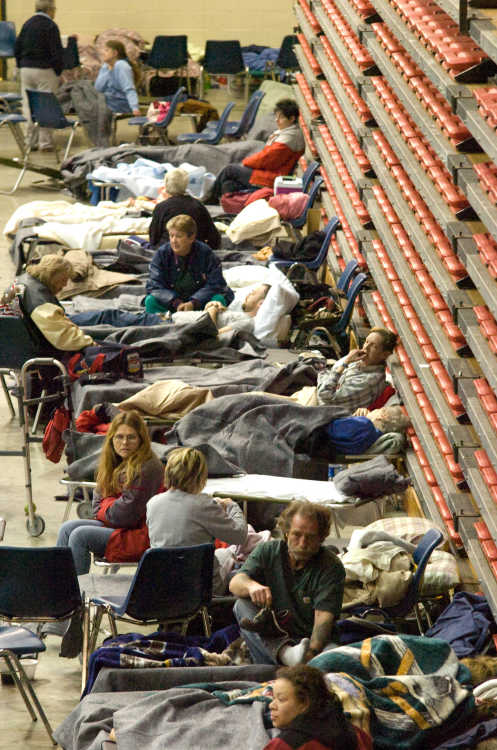 People get settled Jan. 29, 2009, in a shelter at the Black River Coliseum. By Jan. 30, 2009, more than 2,000 people were being served in 35 Missouri shelters because of power outages.
People get settled Jan. 29, 2009, in a shelter at the Black River Coliseum. By Jan. 30, 2009, more than 2,000 people were being served in 35 Missouri shelters because of power outages. -
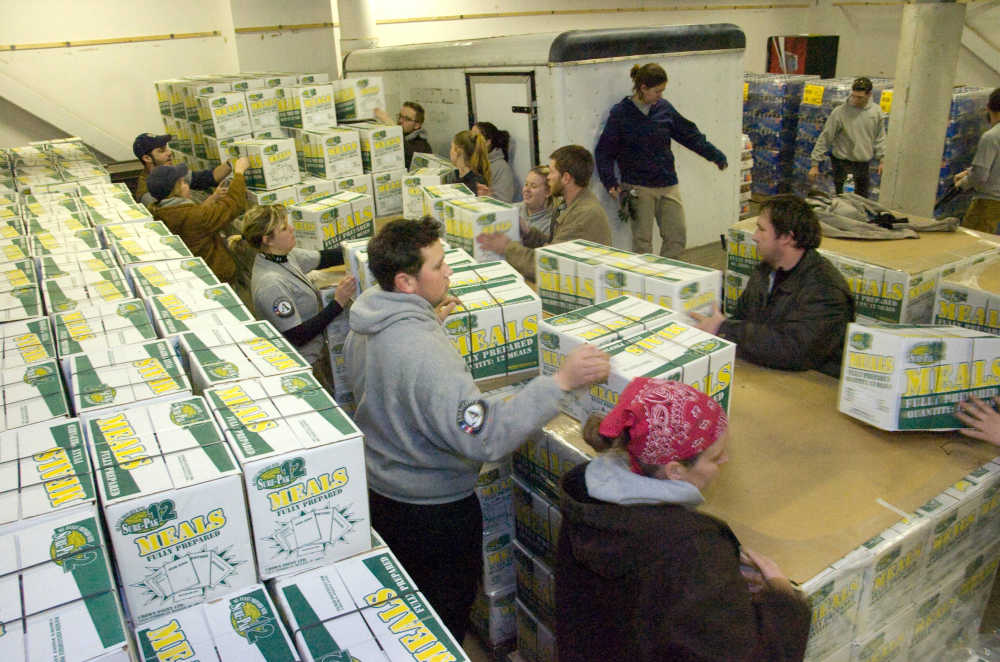 AmeriCorps volunteers and others unload prepared meals Jan. 29, 2009, at the Black River Coliseum, which was opened as a shelter. The Coliseum was opened after an initial shelter at New Covenant Fellowship Church maxed out at 100 people on the night of Jan. 27, 2009.
AmeriCorps volunteers and others unload prepared meals Jan. 29, 2009, at the Black River Coliseum, which was opened as a shelter. The Coliseum was opened after an initial shelter at New Covenant Fellowship Church maxed out at 100 people on the night of Jan. 27, 2009. -
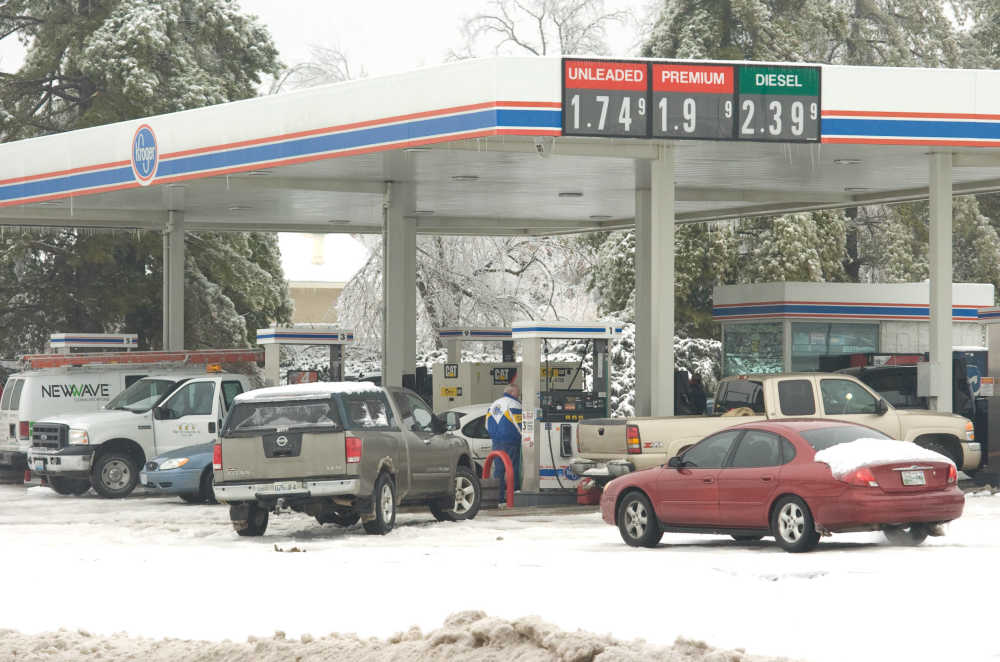 Vehicles line up Jan. 28, 2009, at a Poplar Bluff gas station after power outages cause fuel shortages. Officials reported no fuel was available on U.S. 67 between Poplar Bluff and Bald Knob, Arkansas.
Vehicles line up Jan. 28, 2009, at a Poplar Bluff gas station after power outages cause fuel shortages. Officials reported no fuel was available on U.S. 67 between Poplar Bluff and Bald Knob, Arkansas. -
 Mariah Cooper, Sheyanne Braden and Moses Valdillez play in the snow Jan. 28, 2009, in Poplar Bluff, after about 4 inches of snow falls.
Mariah Cooper, Sheyanne Braden and Moses Valdillez play in the snow Jan. 28, 2009, in Poplar Bluff, after about 4 inches of snow falls. -
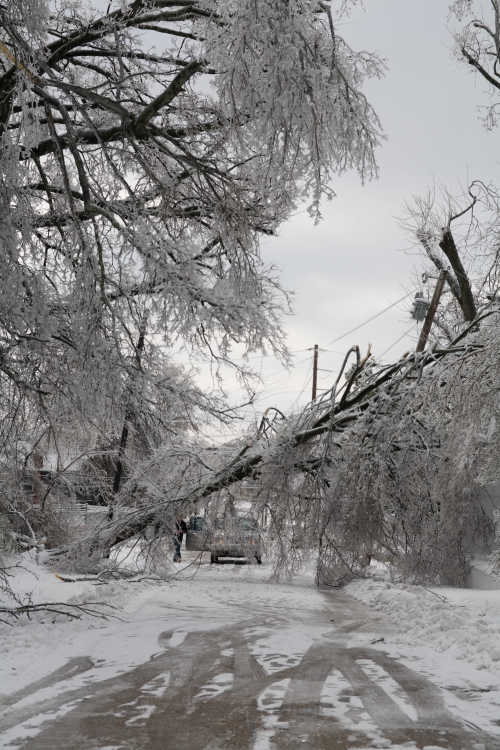 Motorists look at a fallen tree on Fifth Street in Poplar Bluff on Jan. 28, 2009.
Motorists look at a fallen tree on Fifth Street in Poplar Bluff on Jan. 28, 2009. -
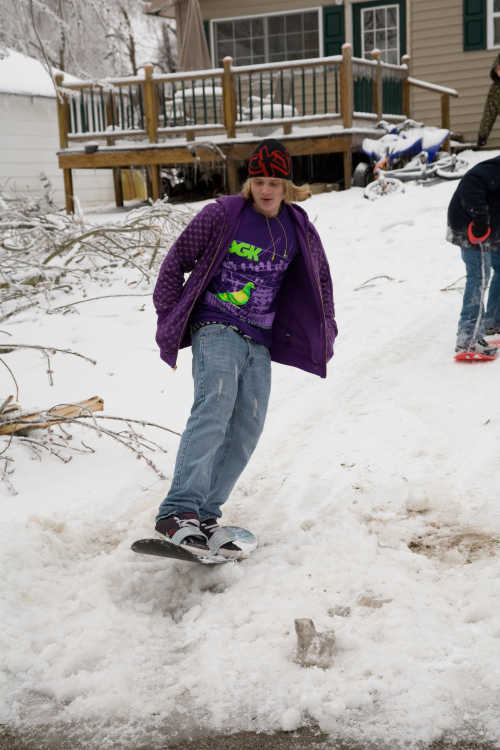 Frankie Burkhart snowboards in January 2009, down a driveway in Poplar Bluff.
Frankie Burkhart snowboards in January 2009, down a driveway in Poplar Bluff. -
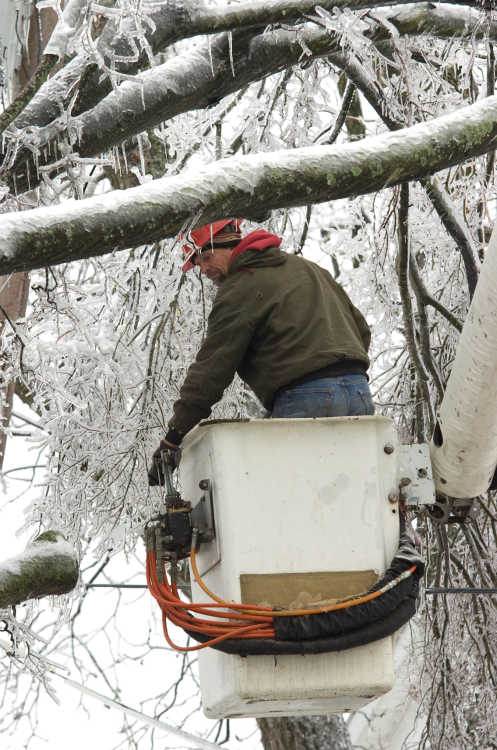 Roger Mattingly uses a chainsaw Jan. 29, 2009, to remove a portion of a large oak tree that fell along Sixth Street in Poplar Bluff.
Roger Mattingly uses a chainsaw Jan. 29, 2009, to remove a portion of a large oak tree that fell along Sixth Street in Poplar Bluff. -
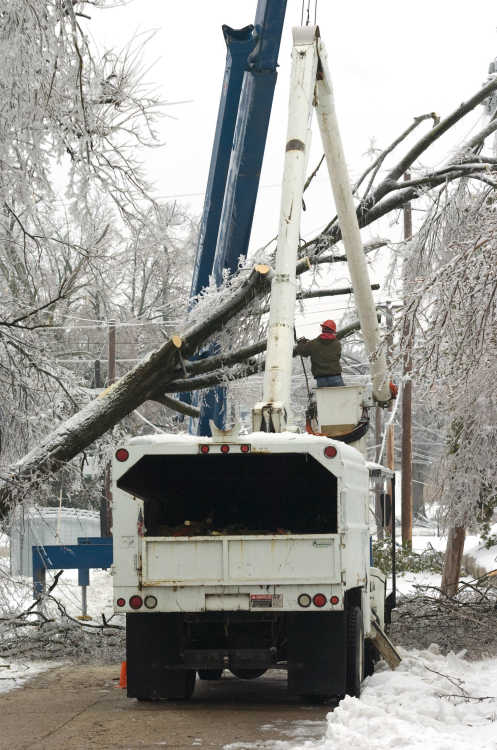 Crews work Jan. 29, 2009, to remove downed trees in Poplar Bluff.
Crews work Jan. 29, 2009, to remove downed trees in Poplar Bluff. -
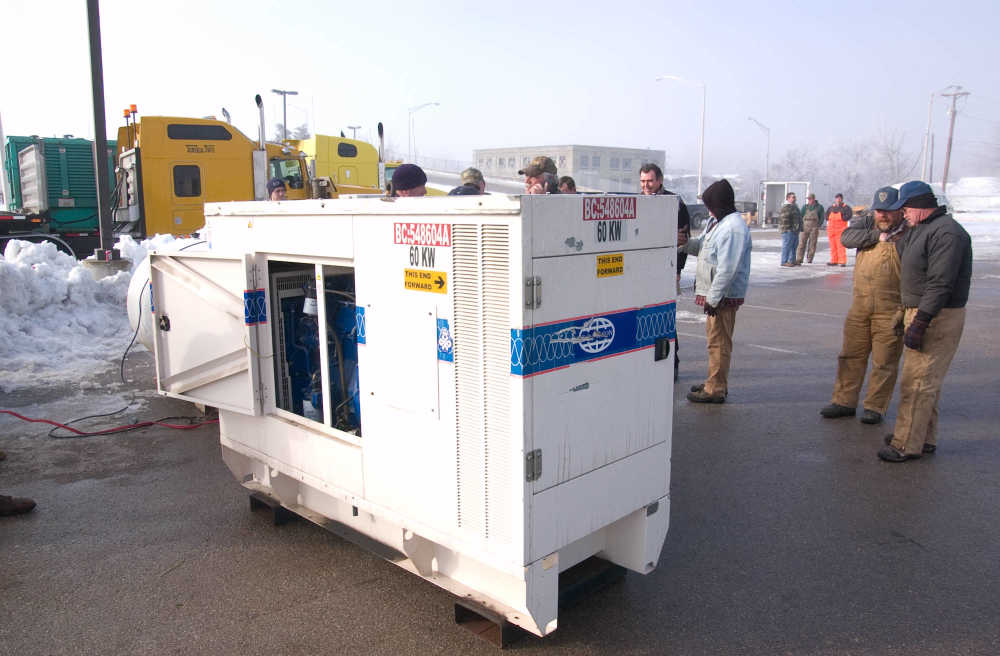 Generators are unloaded Jan. 31, 2009, in the parking lot of the Black River Coliseum after a catastrophic ice storm leaves 500,000 people, including hospitals and businesses, in Missouri and Arkansas without power.
Generators are unloaded Jan. 31, 2009, in the parking lot of the Black River Coliseum after a catastrophic ice storm leaves 500,000 people, including hospitals and businesses, in Missouri and Arkansas without power. -
 Poplar Bluff police officers Andy Cleaveland (right) and Scott Phelps speak Jan. 31, 2009, with people at a shelter at the Black River Coliseum. The shelter was serving 400 people within the first 24 hours of opening its doors.
Poplar Bluff police officers Andy Cleaveland (right) and Scott Phelps speak Jan. 31, 2009, with people at a shelter at the Black River Coliseum. The shelter was serving 400 people within the first 24 hours of opening its doors. -
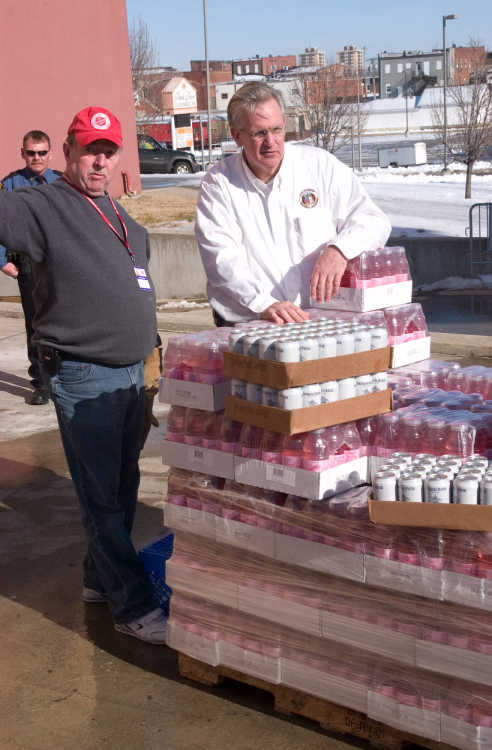 Gov. Jay Nixon speaks with workers Jan. 31, 2009, at a shelter at the Black River Coliseum. A federal disaster declaration was issued that weekend.
Gov. Jay Nixon speaks with workers Jan. 31, 2009, at a shelter at the Black River Coliseum. A federal disaster declaration was issued that weekend. -
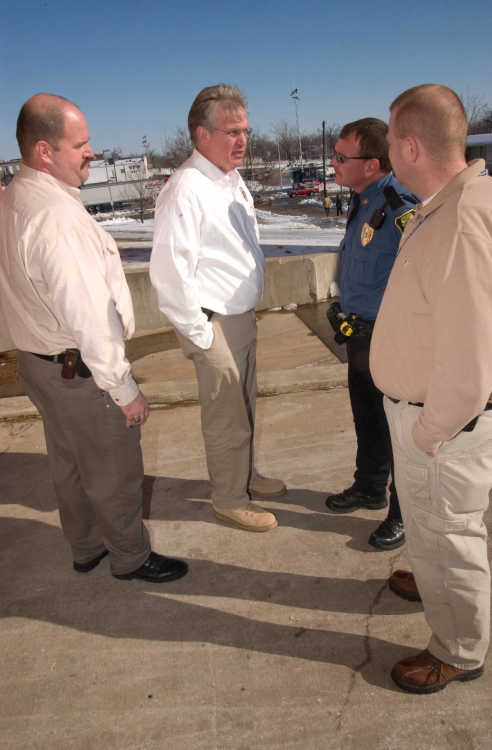 Gov. Jay Nixon speaks Jan. 31, 2009, at the Black River Coliseum with Poplar Bluff police officers, including Steve McCane (left) and Scott Phelps (right).
Gov. Jay Nixon speaks Jan. 31, 2009, at the Black River Coliseum with Poplar Bluff police officers, including Steve McCane (left) and Scott Phelps (right). -
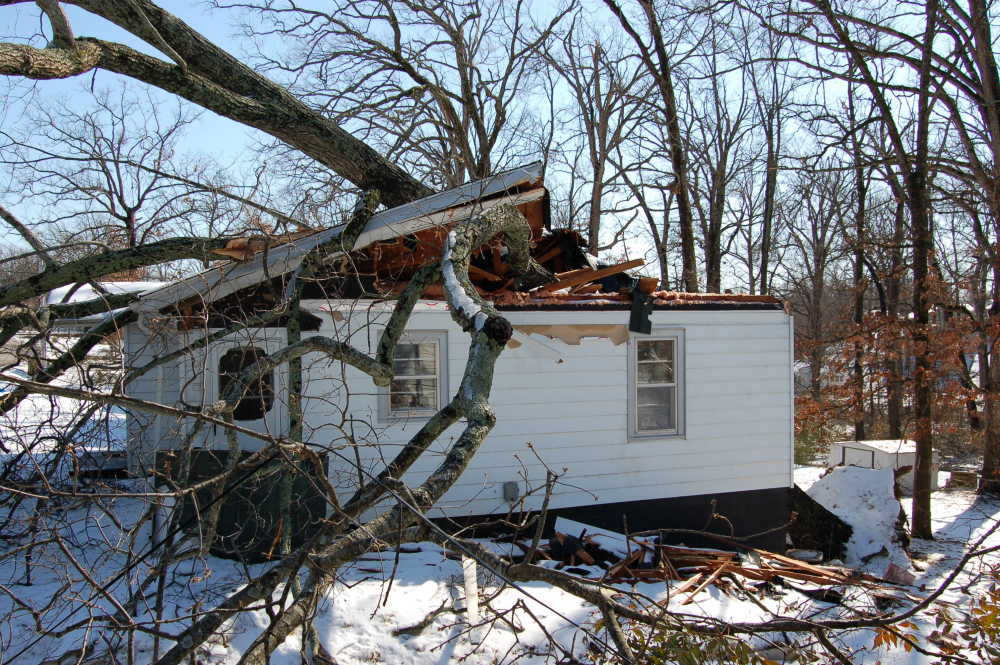 A fallen tree is shown Feb. 2, 2009, on a Kendall Street home in Poplar Bluff.
A fallen tree is shown Feb. 2, 2009, on a Kendall Street home in Poplar Bluff. -
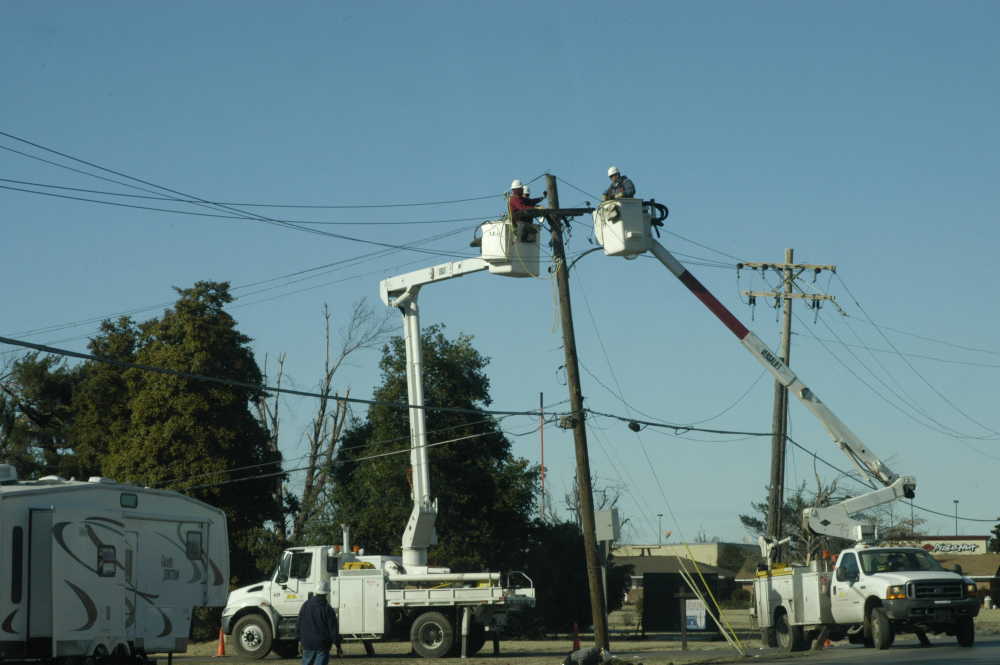 Utility crews work in early February 2009 to restore power to residents in Malden. A shelter set up at the school served 7,000 meals over nine days to residents in need.
Utility crews work in early February 2009 to restore power to residents in Malden. A shelter set up at the school served 7,000 meals over nine days to residents in need. -
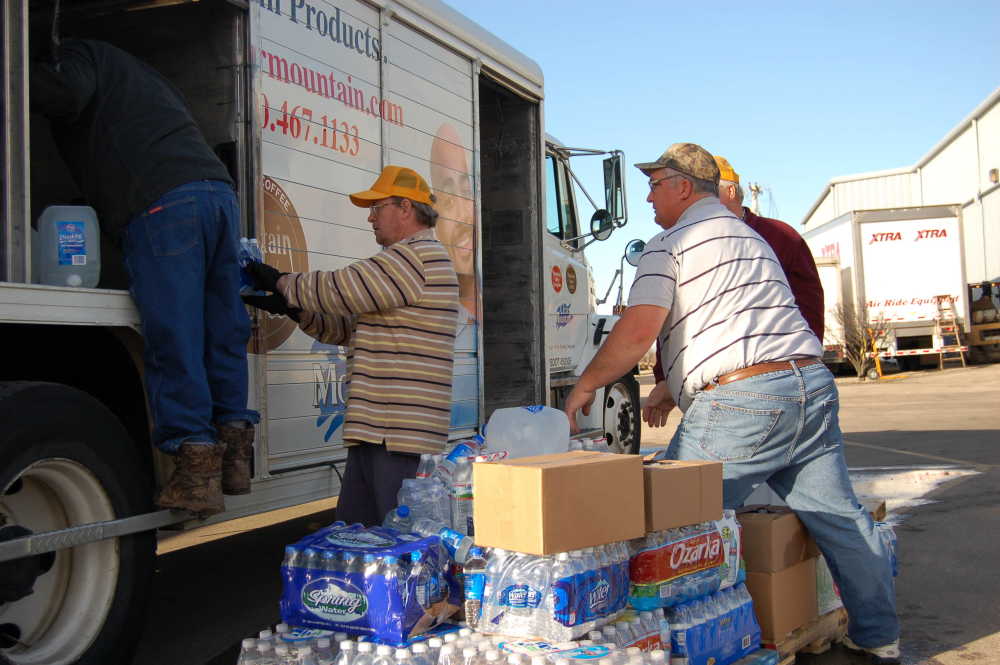 Volunteers unload water and supplies Feb. 2, 2009, at a shelter in Corning, Arkansas. After receiving 2 inches of ice and additional sleet and snow, some residents were without power for up to 27 days.
Volunteers unload water and supplies Feb. 2, 2009, at a shelter in Corning, Arkansas. After receiving 2 inches of ice and additional sleet and snow, some residents were without power for up to 27 days. -
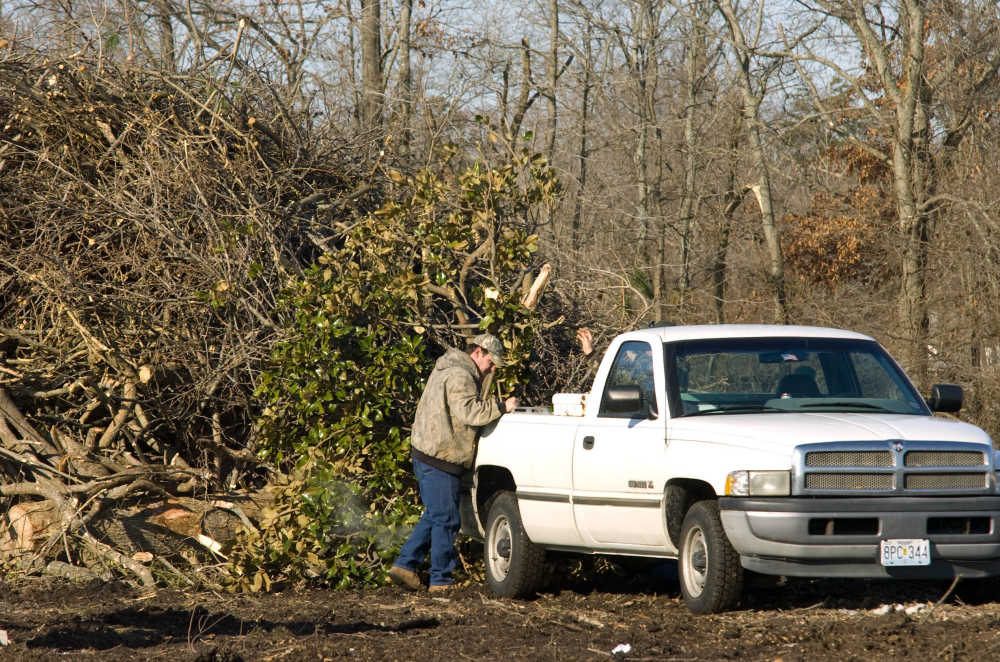 Trees and limbs damaged in the Jan. 26-28, 2009, winter storm are unloaded at a Poplar Bluff collection site. Contractors would collect an amount equal to 39,000 full size pickup truck loads from within the city limits alone.
Trees and limbs damaged in the Jan. 26-28, 2009, winter storm are unloaded at a Poplar Bluff collection site. Contractors would collect an amount equal to 39,000 full size pickup truck loads from within the city limits alone. -
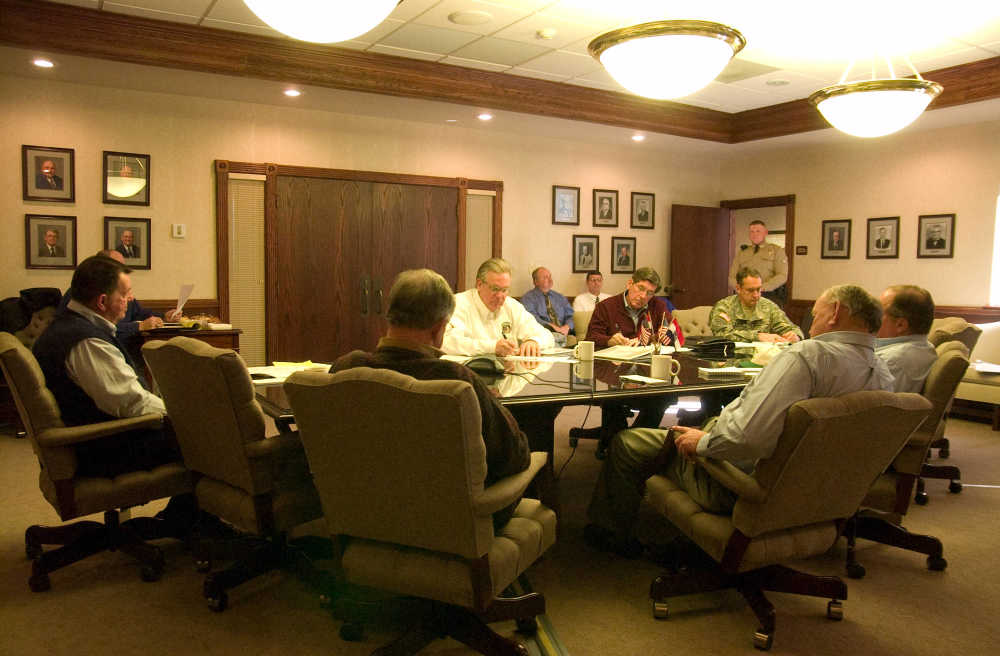 Gov. Jay Nixon speaks with Poplar Bluff emergency services members in early February 2009, as the area continues to recover from a devastating ice storm.
Gov. Jay Nixon speaks with Poplar Bluff emergency services members in early February 2009, as the area continues to recover from a devastating ice storm. -
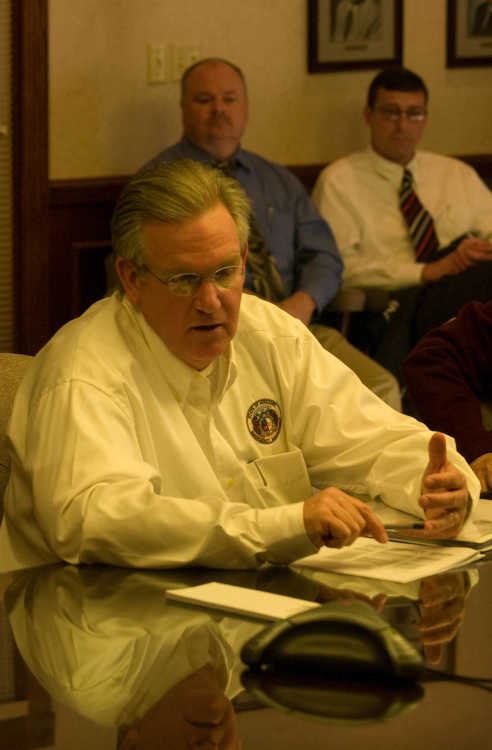 Gov. Jay Nixon speaks in early February 2009 to Poplar Bluff first responders, with Poplar Bluff police officers Jeff Rolland and Donnie Trout seated behind him.
Gov. Jay Nixon speaks in early February 2009 to Poplar Bluff first responders, with Poplar Bluff police officers Jeff Rolland and Donnie Trout seated behind him. -
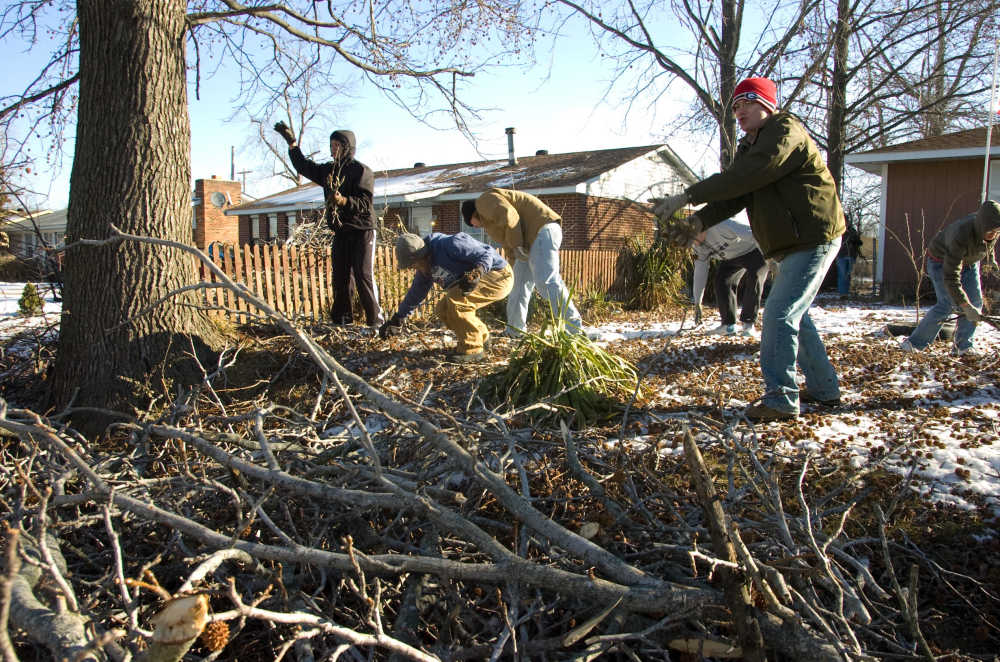 Volunteers help clear debris from a Poplar Bluff neighborhood.
Volunteers help clear debris from a Poplar Bluff neighborhood. -
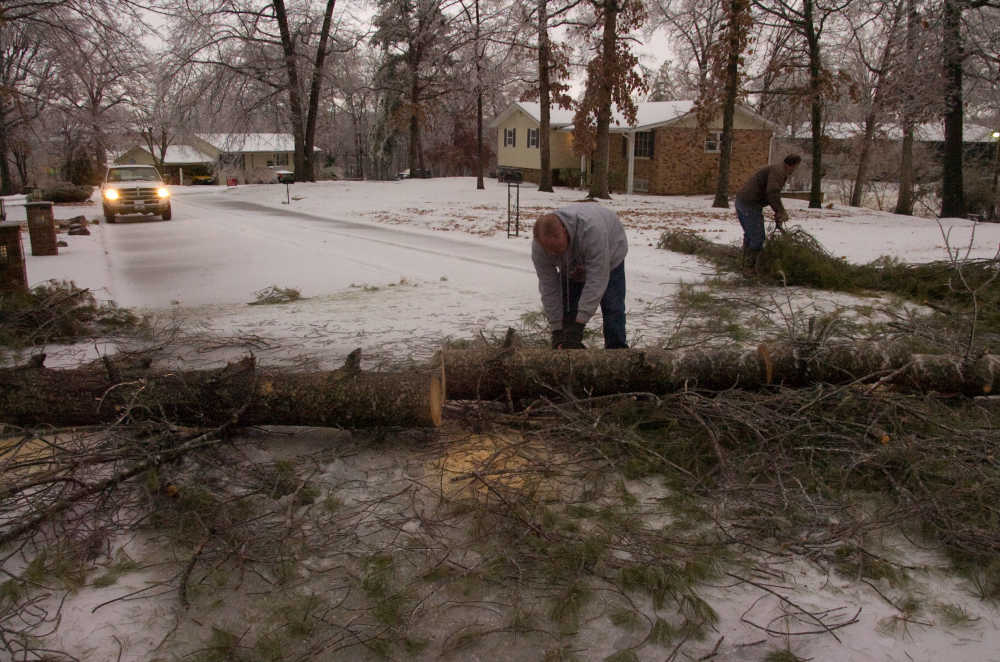 Workers cut up downed trees in January 2009 in Poplar Bluff.
Workers cut up downed trees in January 2009 in Poplar Bluff. -
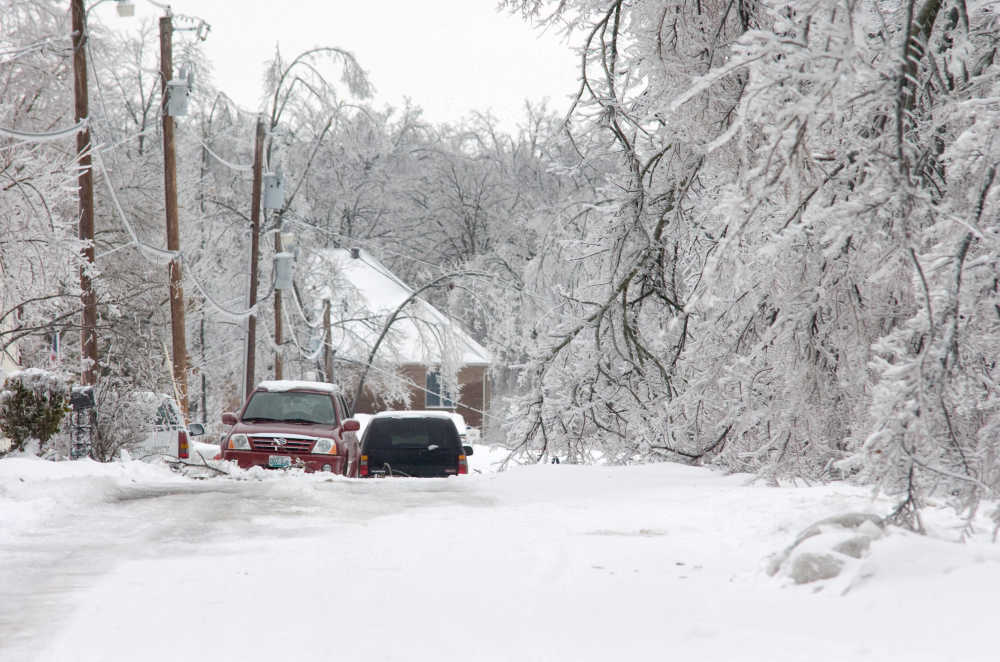 Vehicles travel a Poplar Bluff street in January 2009, following an ice and snow storm.
Vehicles travel a Poplar Bluff street in January 2009, following an ice and snow storm. -
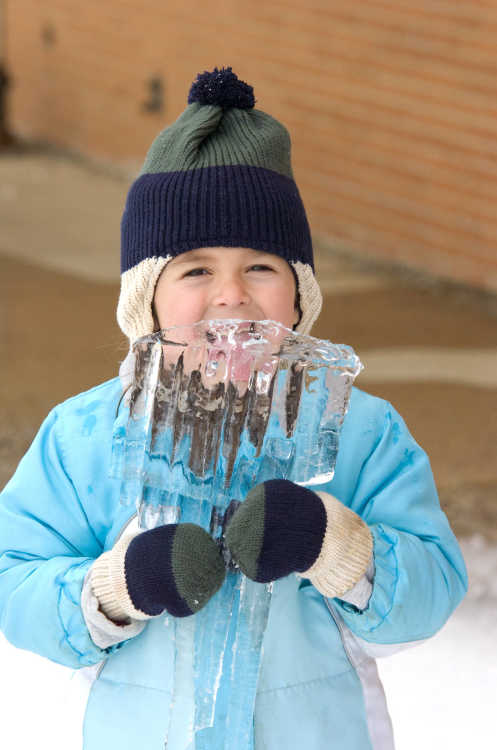 Kamryn Sturgeon, 7, holds an icicle Jan. 28, 2009.
Kamryn Sturgeon, 7, holds an icicle Jan. 28, 2009. -
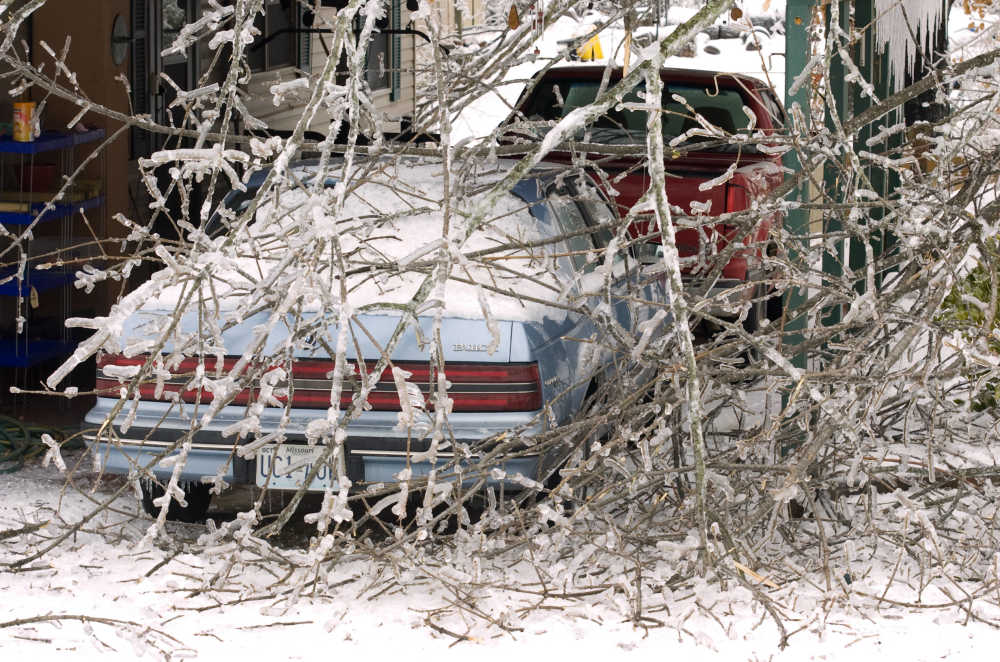 Ice covered tree limbs block vehicles in Poplar Bluff in January 2009.
Ice covered tree limbs block vehicles in Poplar Bluff in January 2009. -
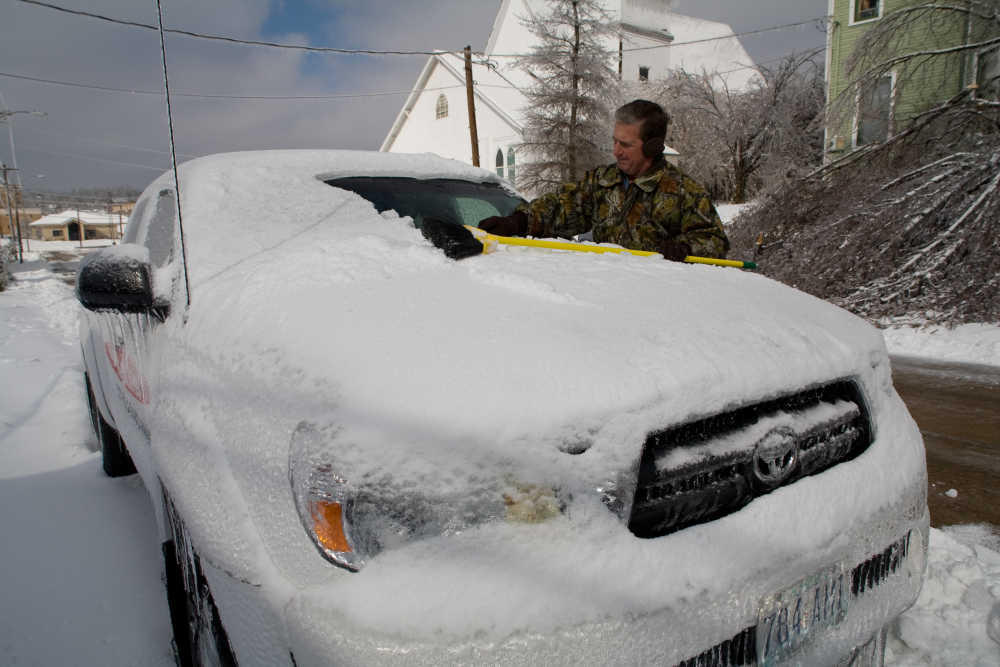 Allen Christian scrapes a thick layer of ice and snow off his vehicle Jan. 28, 2009.
Allen Christian scrapes a thick layer of ice and snow off his vehicle Jan. 28, 2009. -
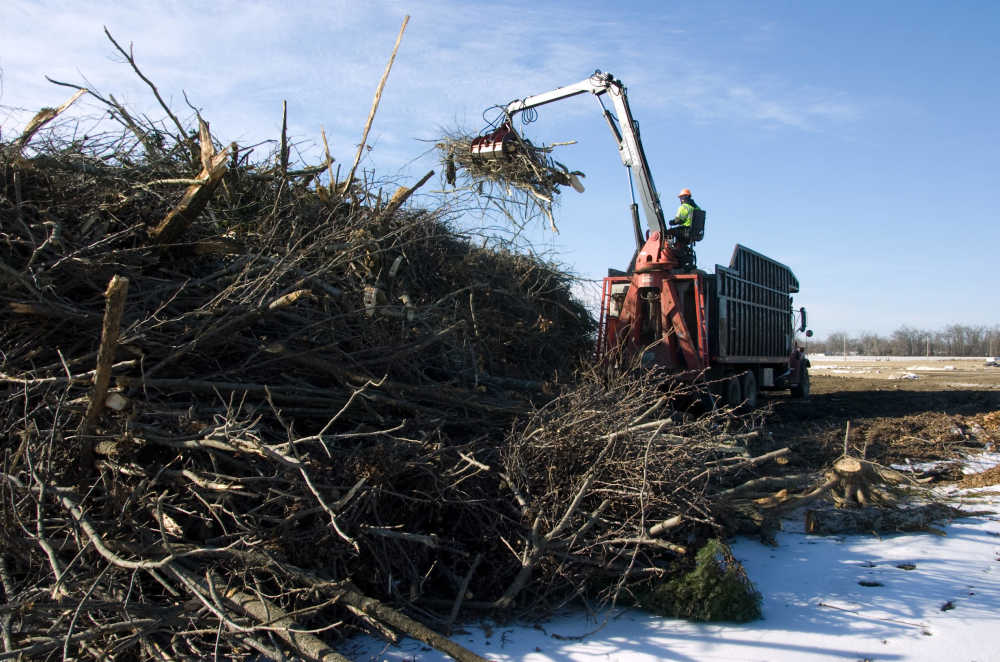 Trees and limbs are disposed of at a Poplar Bluff collection site in February 2009, as clean up continues.
Trees and limbs are disposed of at a Poplar Bluff collection site in February 2009, as clean up continues.
Area marks 10 years since weather event of the decade, the 2009 ice storm
The National Weather Service calls it the weather event of the decade, but for local residents, the 2009 ice storm probably still seems even more significant.
The full brunt of that weather front left over 1 million people without power across nine states, including entire communities, like Dexter and Corning. The area saw as much as 2 inches of “catastrophic” icing and another 2-10 feet of snow accumulation between Jan. 26-28, 2009.
“This one humbled us. We walked out of this one on our knees,” Stan Estes, then-manager of Ozark Boarder Electric Cooperative, said at the time, after OBEC suffered $29 million in damage.
Preliminary damage estimates were in the neighborhood of one-half billion dollars in the Paducah National Weather Service forecast area, the NWS reports.
By late February 2009, Poplar Bluff alone was awarding a $1.4 million contract to remove what would end up being nearly 100,000 cubic yards of downed limbs and trees just from within the city limits. The amount of debris was equal to about 39,000 full size pickup truck loads.
It took two years or more for some electric utility companies to fully recover, and area officials say other impacts from the disaster are still being felt.
Butler County commissioners believe log jams in the Black River south of Poplar Bluff were made much worse by the amount of debris that fell into the waterway or later washed into the river because of flooding.
They blame log jams along a 35-mile section of the river for flooding in recent years of Highway 53 between Poplar Bluff and Qulin, as well as surrounding farmland. The commission continues to work on this problem with the U.S. Army Corps of Engineers and other entities that have to be consulted, according to presiding commissioner Vince Lampe, who began discussions with the Corps as early as 2016.
Throughout the response to what area county officials described at the time as the worst disaster in memory, 61 shelters were opened for residents in Missouri and 80,000 meals served.
Some families, like Shelly Reagan and her children in Pollard, Arkansas, were without electricity in their homes for nearly a month.
“This is the most widespread disaster we’ve ever had,” Travis Boyd, then-Clay County coordinator for the Office of Emergency Services, said later that year. “We didn’t have a single outlet burning in the county by the second day.”
More than 65,000 electric poles throughout the area were taken down by the ice.
The strain on emergency services, first responders and utility workers was extreme.
“The first two days were the worst,” said Brien Fugate, then-market general manager for Rural Metro Ambulance Service. “We average about 20 runs a day and we went to almost 40 runs a day, not counting the 15 to 20 welfare checks we did each day.”
One ambulance crew hiked a mile, crawling through fallen trees and crossing downed power lines to reach a patient.
Dunklin County collected nearly 383,000 cubic yards of debris, or about 153,000 full size pickup truck loads. School personnel in Malden opened a shelter for families, serving 7,000 meals over nine days.
“I wasn’t surprised our community came together to do this. It’s just that kind of people who live here,” Carolyn Goode, then a school cook said later that year. “People all over town pitched in and worked as equals.”
Other communities, like the Dudley Special Road District in Stoddard County, didn’t wait for the federal emergency declaration and outside help. They cleared 70 miles of pavement following the ice storm.
“We used our own tractors. We got these roads open where people could travel. That was our job,” then-board member Bob Hardin said.
Parts of Stoddard County were without electricity for 23 days. Power outages also led to fuel shortages, because of the number of gas stations shut down.
“It was like a month-long nightmare,” said Frank Sifford, then-Stoddard County associate commissioner. “We had miles and miles of electric lines down. The ice storm was really widespread.”
About 90 percent of Ripley County was without power immediately following the storm.
“During the emergency, you could really see the community pulling together,” said Connie Teslow, then-Doniphan city clerk. “At meetings, we said how proud we were not just of the people whose job it is to provide services, but of the ordinary people who pitched in to help their neighbors.”
Wayne and Carter counties, like others, reported houses, metal buildings and other structures that collapsed under the weight of snow and ice.
Carter County saw volunteers and first responders use four-wheel drive vehicles to take portable generators to homes to refill oxygen bottles and distribute water.
“We care about our neighbors. We need each other at a time like that. That’s the way it goes, or at least it should,” an official with the City of Grandin said.
